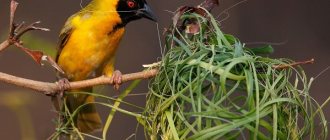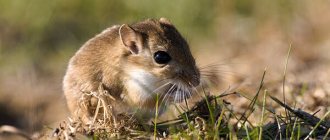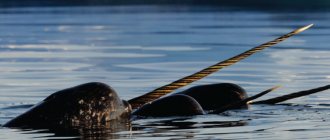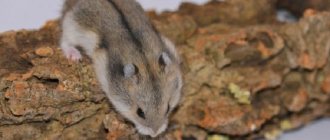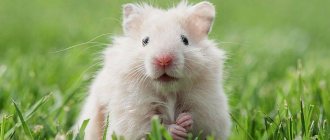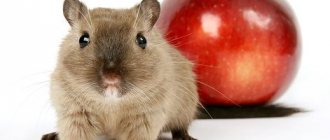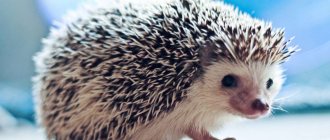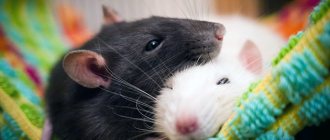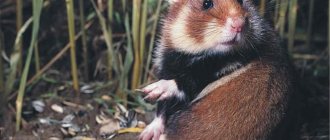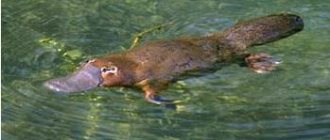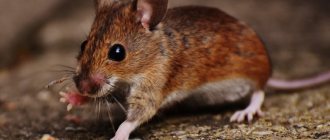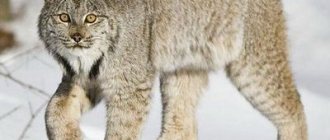| Latin name: | Spinus |
| English name: | Siskin |
| Kingdom: | Animals |
| Type: | Chordata |
| Class: | Birds |
| Squad: | Passeriformes |
| Family: | Finches |
| Genus: | Siskins |
| Body length: | 11-13 cm |
| Wing length: | 8-11 cm |
| Wingspan: | 20-23 cm |
| Weight: | 12-14 g |
- 7.1 What will the siskin need?
Description of the bird
It is not surprising that the siskin - a small funny songbird - is very often called a siskin. Yes, and the song “Chizhik-Pizhik” is also about him. It is enough to see and hear this bird once to understand what causes such an affectionate attitude towards it.
Siskins belong to the finch family, which includes many wonderful singers. The size of this bird is small: only about 12-15 g body weight, body length - 12 cm, wingspan - 20-22 cm.
— Advertising —
And, despite the fact that siskins are very well camouflaged in the treetops, when you see this bird, it is very easy to recognize it. The plumage of an adult male siskin has a bright green-yellow coloring of the head, neck and abdomen. The dark wings are also decorated with lemon spots. And males, unlike females, “wear” a black cap on their heads. Females and young males are colored brownish-brown, sometimes with yellow splashes.
Appearance and features
Photo: Siskin bird
Siskins have much in common with representatives of their order, passeriformes. They are small in size. The body length does not exceed twelve centimeters, and the weight is no more than sixteen grams. Such dimensions are completely characteristic of ordinary sparrows. However, the siskin cannot be compared with a sparrow. The closest relatives of these birds are goldfinches, from which they often steal and perform songs.
To date, ornithologists have identified nineteen varieties of siskins. They all differ in habitat, behavior, and color. The color can be green-yellow, olive, red, pale gray. The most numerous species live closer to people, populating forests, parks, and gardens. Rare species prefer to live away from people.
Despite some differences, all types of siskins are characterized by certain external qualities:
- small but strong wings. Their span is twenty centimeters;
- Quite a long tail. It consists of regular and tail feathers. In most cases, the tail color is lemon yellow, and the tail feathers have a characteristic white edge;
- thin but tenacious legs. The toes are hooked and have short nails. Such paws allow the animal to hold firmly on tree branches;
- small, thin beak. It has a slightly convex shape, pointed at the end. This shape and structure of the beak are very unusual for representatives of the passerine order;
- small head, round body. In most varieties, the head is decorated with a special cap of black feathers. The birds' eyes are also coal-black, with yellow stripes visible above them. Externally, the stripes resemble eyebrows.
Where do siskins live?
The habitat of all types of siskins is very wide. This includes Europe, Asia, North America, and South America. That is, these birds are found almost everywhere. They prefer to live in mixed forests with tall trees, where they feel safe and can hide well, as well as in high mountains.
Lifestyle and habitat
The wide habitat of siskins makes it possible to observe birds almost everywhere. Different species are found in the European part of the continent, Asia, the British Isles, Brazil, South and North America. Siskin is a migratory bird that tends to appear in areas where warm seasons persist at any time of the year.
Listen to the voice of the siskin
Habitat areas are numerous. Birds prefer mountainous areas and settle in mixed forests. The voice of the siskin can be heard in spruce forests, thickets of grass, and bushes. Closer to autumn, birds migrate, moving short distances along river valleys closer to warmth and food. There is a dispute among ornithologists whether siskins should be considered migratory or nomadic birds. Spring migrations occur from early March to late April, winter migrations - at the end of September and October.
As the weather gets colder, small birds appear in alder thickets and birch groves; city residents see them in parks and squares. If the siskins manage to find a non-freezing reservoir, they can stay nearby for the winter. In warm areas, birds do not change their habitat.
Birds are very active in behavior and may seem restless. The internal structure of siskins is characterized by cohesion; they stay together and are always located nearby. Birds do not live alone. Even during the mating season, they build nests nearby; up to six settled pairs can be observed on neighboring trees.
Male (right) and female American Siskin
Siskins have a kind of sharing of food, when food is “delivered” to other members of the flock by regurgitating food. Birds stay higher from the ground, among the treetops, hiding in the crowns. You can see a siskin jumping on the ground only occasionally.
In captivity, siskins easily take root. They are recognized as the most “tame” in comparison with canaries, goldfinches and other songbirds. The chirping of siskins creates a special atmosphere without getting boring. Birds captivate with their intelligence and gullibility. Sometimes they need to travel around the house to spread their wings and make short flights. They easily return to their abode with the understanding that this is their place.
Fidgets need a spacious cage for an active life. A bathtub for bathing is required, in addition to a drinking bowl. Good conditions contribute to the reproduction of pets. You will need coniferous branches in the corner of the cage, a platform for the nest, and building material in the form of scraps of cotton wool, feathers, grass, and moss. During the nesting period, birds are not disturbed by cleaning, and food is left on the wall opposite the nest. The chances of offspring increase when the conditions are met.
Siskin in flight
The home diet includes grain mixtures, which can be based on millet, rapeseed, oatmeal, and canary seed. The seeds of birch, alder, coniferous trees, as well as dandelion, plantain, and flax are useful for birds. Siskins feast on pieces of apples and carrots and do not refuse garden greens.
Feeding chicks requires special animal supplements. If it is not possible to find insect larvae, then the food is enriched with chicken eggs. The boiled product is grated and mixed with crushed crackers and carrots.
Is the siskin a migratory bird or a sedentary one?
— Advertising —
Siskins are typical migratory birds. At the end of September they gather in large flocks and move south – closer to the warmth. That is why in winter you can often find siskins, for example, in the Crimea. Only in very rare cases, if in their habitat these birds find an ice-free body of water - a river, lake, stream - they can stay near it for the winter.
Reproduction in the natural environment
For their nest, birds choose the tallest and densest spruce or pine trees. The place for future children should, according to parents, be no lower than 10 meters from the ground.
Both the female and the male participate equally in the construction of the nest. They carefully intertwine thin twigs, roots, blades of grass, after which they cover the resulting (rather deep) bed with soft down, feathers and wool.
The nest is a building in the form of a hemisphere. Its base is located near the trunk itself, which is covered with lichen for camouflage, matching the nest itself.
The siskin's nest is carefully hidden from prying eyes; it is almost impossible to find it in nature
Egg laying occurs at the end of April or early May. Usually the female lays 5-6 eggs; they are uneven in size and may differ from each other in color.
The size of the siskin egg varies from 14 to 18.5 mm in length. The color of the shell is white with a blue or greenish tint, numerous dots, lines and scribbles are dark burgundy.
Parents carefully look after the chicks
The female incubates the chicks for about 12-14 days. Both parents take care of the children's nutrition, bringing them various insects, caterpillars and larvae.
The babies grow very quickly and already on the 15th day they are ready for their first flight.
In a few weeks, the young generation, having become adults, will make room for the next offspring. After all, siskins typically reproduce twice a year.
What does a siskin look like?
The siskin species includes 19 varieties. What distinguishes them is, first of all, their distribution area, as well as their color and behavioral characteristics. The most famous types:
Golden siskin
A North American species, also known as the American goldfinch. For the winter, these birds migrate to Mexico and change color. Lemon yellow males turn pale green.
Mexican Siskin
Inhabitant of high mountain regions of North and South America (from 900 m). These birds are very careful and difficult to spot in nature.
Pine Siskin
Found in the mountains of North America. It is colored paler than other types of siskins, in brown-yellow tones.
Fire Siskin
The most striking representative of siskins. Its head, wings and tail are jet black, and the rest of its plumage is bright carmine red. This species is slightly larger than the common siskin. Distributed in northern Venezuela, where it is a protected species.
Nutrition
In the natural environment, the siskin's diet includes plant and animal foods. In spring and summer, siskins feed on small insects, caterpillars, aphids, and butterflies. By autumn, as they ripen, the seeds of deciduous and coniferous trees - alder, birch, poplar, fir, pine, spruce - become a delicacy for birds. Dandelions and poppy are of nutritional value.
Siskins eat sunflower seeds in winter
The thin, pointed beak of the siskin allows it to obtain seeds of asteraceous plants - thistle, cornflower, meadowsweet, and sorrel. Birds extract nuts from the cones of coniferous plants. Hook-shaped claws hold birds on tree branches, even when hanging upside down.
Male and female: main differences
In siskins, sexual dimorphism is moderately expressed. As usual, male siskins show off their bright and attractive emerald-golden plumage, while females look modest and do not attract attention. This natural cunning is necessary so that the brownish-brown female is not noticeable in the nest while incubating eggs.
What is the difference between a greenfinch and a siskin?
Siskins are sometimes confused with greenfinches, which is understandable, because they are really very similar. To understand what a siskin bird looks like, it is enough to remember their main feature - the dark crowns on their heads.
Since their beaks are almost identical, as is the color of their plumage, siskins have more stripes than greenfinches, they have a sharper forked tail, and their crowns are black (only males have black crowns, and therefore there is a greater chance of confusing female siskins with greenfinches).
Siskins at home
Siskins are real favorites among songbird connoisseurs.
Firstly, they sing a lot and with pleasure almost 10 months a year. It’s simply impossible to get bored with such a bird at home!
Secondly, siskins very quickly get used to captivity and become truly tame birds. The owners of the siskin will always be able to safely leave the cage open - the birds will always return to their place and will not stain the room. In addition, the siskin can be taught various tricks - drinking water from the owner’s mouth, for example.
Thirdly, if all the necessary conditions are created for siskins, they can also hatch chicks in captivity.
And finally, if in the wild birds usually live for 3 years, then at home they live up to 10-12 years.
What will Chizhu need?
Siskins do not need a lot of space - the cage can be small, like for a parrot. The main thing is that it does not stand in bright sunlight or drafts.
Siskins also love water treatments, so in addition to the usual drinking bowl, they will need a special container of water for bathing.
It is better to keep birds in pairs or flocks. You can also add neighbors to the siskins. These birds will not only receive guests, but can also learn their singing skills.
In order for the birds to start nesting, they need to create a secluded corner of plywood in the cage, decorate it with spruce and pine branches, and leave material for construction - twigs, feathers, blades of grass.
In nature, siskins lay 2 clutches per year. At home, they also lay up to 6 small light-colored eggs with brown spots and stripes. The female incubates them for 12 days. And then it takes about 2 weeks for the chicks to grow up. Parents feed their babies mainly protein foods - caterpillars and insects.
Eating at home
Siskins are absolutely picky when it comes to food. Like all granivorous birds, they will need plenty of clean drinking water. You can feed siskins with any mixtures of seeds and grains (birch, poppy, flax, alder and others). In addition, greens, fruits and vegetables are added to the diet. For example, cabbage, carrots, apples.
Features of character and lifestyle
Photo: Chizh in winter
The life of siskins is in constant motion. In the warm season they nest. For this, birds choose tall trees; most often, nests are found at the very tops of coniferous trees. To build a nest, siskins unite in pairs. The female and male work together to build the nest. The male usually finds and brings suitable material, and the female carefully builds a “house” for future offspring.
The nest is built from inconspicuous material. Birds often use lichens and moss for this purpose. Such building material merges with the branches of a coniferous tree, so it is almost impossible to immediately detect a siskin nest. The birds lay blades of grass inside the nest. Inside the nest it is always cozy and warm. Plus, green grass also serves as a certain camouflage.
Foresight is the main quality of siskins. Little birds make their “houses” inconspicuous for a reason. With the help of camouflage, they protect eggs and hatched chicks from potential danger. Nests are difficult to locate. In addition to building a nest, during the day the birds search for food. They quickly move from one tree to another, where they obtain seeds. Birds practically do not walk on the ground. They only occasionally descend to the ground to collect a blade of grass, find plant seeds, or catch insects for their young.
Siskins have a wonderful character. These are kind, calm, cheerful, perky animals. They spend the whole day flying and singing beautifully. Siskins are easily tamed and become obedient pets. Such birds quickly become attached to their owners and delight them with melodic and soothing singing every day.
Interesting facts about siskins
- Siskins are real masters of camouflage; in nature, they arrange their nests in such a way that it is almost impossible to find them; that’s why they even say that siskins hide special pebbles in their nests that make them invisible;
- in addition to its own song, the siskin can easily and very reliably parody other birds if it lives next door to them;
- Siskins not only quickly get used to captivity, but also remember well the person who is looking after them, rejoice at his arrival and greet him with singing.
Characteristic
At first glance, the siskin is inconspicuous, quiet and has a timid character. But after a short acquaintance, the bird shows interest and friendliness, causing positive emotions in its admirers.
The siskin sings songs consisting of a variety of trills and often imitates the singing of other birds, especially tits.
And in free flight, the siskin tirelessly makes its calling sound, similar to “chilik”, or “siskin”, most likely this is where the custom came to call this bird - “siskin-fawn”, about which that very song was composed.
After this cry, there is usually a chirping noise or something similar.
Interesting fact! In nature, siskins make their nests in the lush branches of tall spruce trees, hiding their offspring from prying eyes. Therefore, it is unlikely that anyone will be lucky enough to stumble upon the shelter of a siskin - it knows how to camouflage itself perfectly.
Siskin in flight
Why is Chizha called that?
Once you hear the cheerful, hasty song of the siskin, it immediately becomes clear where this bird got its name. In noisy flocks, siskins call to each other with trills, in which creaks, crackles, squeaks and the constant buzzing “siskin” sounds can be clearly heard.
Often in this song you can find fragments borrowed from other birds. The naturalist writer Anatoly Onegov described the siskin song perfectly: “The siskin will sing and chirp, you will listen to the little singer, and it seems that it is not a bird, but a stream gently but hastily splashing among the warm pebbles, but then a pleasant stream comes to an end, and instead of that while a beautiful song was sounding, a completely unmelodic “chizhzhzhizhi” would suddenly be heard.
